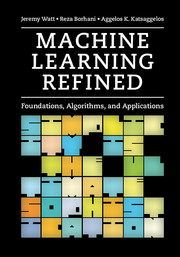1 - Introduction
Summary
Machine learning is a rapidly growing field of study whose primary concern is the design and analysis of algorithms which enable computers to learn. While still a young discipline, with much more awaiting to be discovered than is currently known, today machine learning can be used to teach computers to perform a wide array of useful tasks. This includes tasks like the automatic detection of objects in images (a crucial component of driver-assisted and self-driving cars), speech recognition (which powers voice command technology), knowledge discovery in the medical sciences (used to improve our understanding of complex diseases), and predictive analytics (leveraged for sales and economic forecasting). In this chapter we give a high level introduction to the field of machine learning and the contents of this textbook. To get a big picture sense of how machine learning works we begin by discussing a simple toy machine learning problem: teaching a computer how to distinguish between pictures of cats from those with dogs. This will allow us to informally describe the procedures used to solve machine learning problems in general.
Teaching a computer to distinguish cats from dogs
To teach a child the difference between “cat” versus “dog”, parents (almost!) never give their children some kind of formal scientific definition to distinguish the two; i.e., that a dog is a member of Canis Familiaris species from the broader class of Mammalia, and that a cat while being from the same class belongs to another species known as Felis Catus. No, instead the child is naturally presented with many images of what they are told are either “dogs” or “cats” until they fully grasp the two concepts. How do we know when a child can successfully distinguish between cats and dogs? Intuitively, when they encounter new (images of) cats and dogs, and can correctly identify each new example. Like human beings, computers can be taught how to perform this sort of task in a similar manner. This kind of task, where we aim to teach a computer to distinguish between different types of things, is referred to as a classification problem in machine learning.
- Type
- Chapter
- Information
- Machine Learning RefinedFoundations, Algorithms, and Applications, pp. 1 - 18Publisher: Cambridge University PressPrint publication year: 2016



